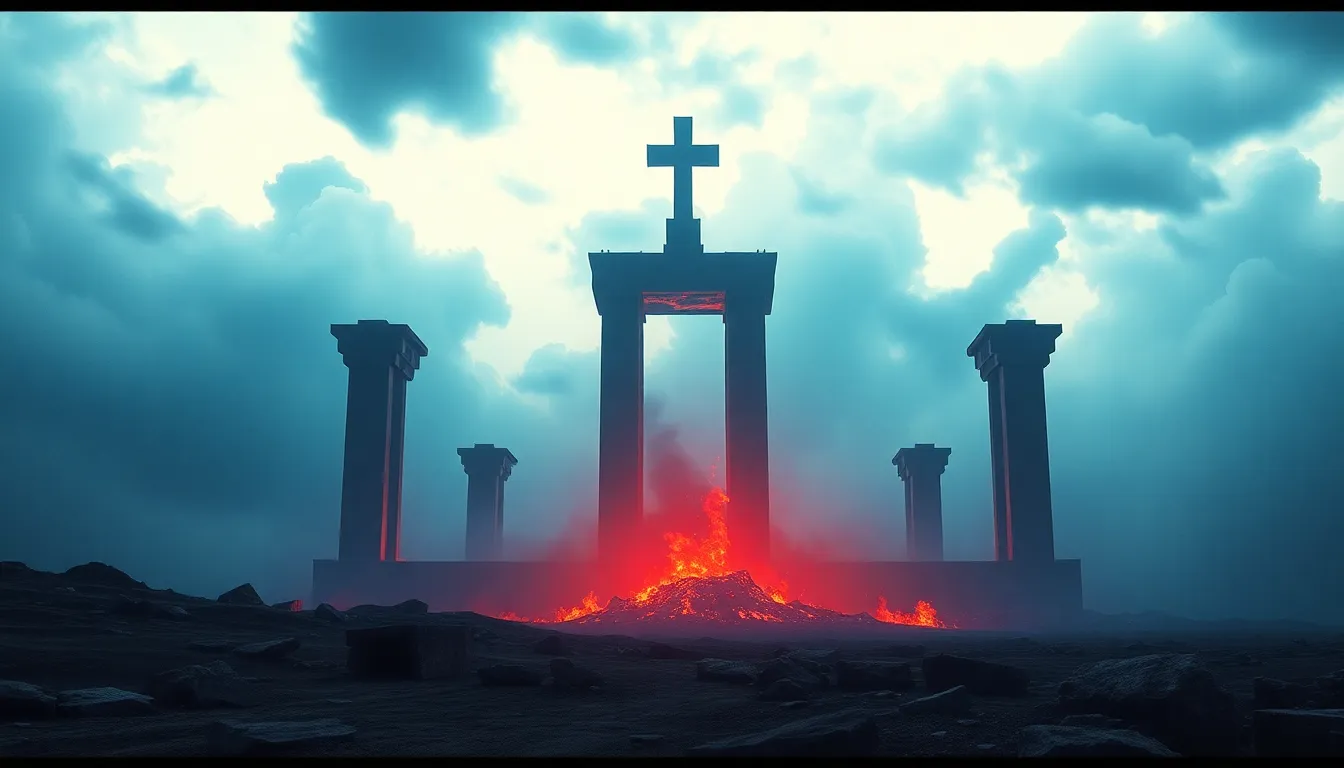The Myths of Armageddon: A Cultural Exploration
I. Introduction
Armageddon is a term that conjures images of cataclysmic battles and the end of the world. In cultural contexts, it often refers to a final confrontation between good and evil, a time when humanity faces divine judgment. The term’s roots can be traced back to the Bible, specifically the Book of Revelation, but its interpretations have evolved over centuries, influenced by various cultures and belief systems.
Exploring the myths surrounding Armageddon is essential for understanding the collective psyche of societies throughout history. These myths reveal not just fears about the future but also values, hopes, and the human condition itself. This article will delve into the historical origins of Armageddon myths, their presence in religious traditions, their representation in literature and art, and their implications in contemporary society.
II. Historical Origins of Armageddon Myths
A. Biblical references and interpretations
The term “Armageddon” originates from the Hebrew “Har Megiddo,” referring to a hill in Israel where battles were fought. The Book of Revelation describes a final battle between the forces of good, led by Christ, and the forces of evil, led by the Antichrist. This vivid imagery has led to various interpretations, from literal predictions of future events to metaphorical representations of moral and spiritual struggles.
B. Influence of ancient civilizations and their apocalypse narratives
Ancient civilizations, such as the Mesopotamians and the Maya, had their own apocalyptic narratives. The Epic of Gilgamesh reflects themes of mortality and the quest for eternal life, while the Maya calendar’s end date in 2012 sparked widespread apocalyptic speculation. These narratives reveal humanity’s longstanding fascination with endings and rebirth.
C. Evolution of Armageddon concepts through history
Throughout history, the concept of Armageddon has evolved. From the early Christian interpretations to the medieval period’s fascination with the end times, each era has redefined what Armageddon means. The Enlightenment brought a rational approach, while the Romantic period emphasized emotion and the sublime. In modern times, global threats such as nuclear war and climate change have given new life to these ancient myths.
III. Armageddon in Religious Traditions
A. Christianity: The Book of Revelation and its interpretations
Christianity’s view of Armageddon is primarily drawn from the Book of Revelation, which describes a series of catastrophic events leading to the second coming of Christ. Different denominations interpret these events variably; some see them as literal future occurrences, while others view them symbolically.
B. Islam: The Day of Judgment and its significance
In Islam, the Day of Judgment (Yawm al-Qiyamah) is a time when all individuals will be resurrected for divine judgment. The Quran describes signs that will precede this day, including widespread chaos and moral decay. This belief emphasizes accountability and the transient nature of life.
C. Hinduism and Buddhism: Cycles of creation and destruction
Hinduism and Buddhism present a different perspective, viewing destruction as part of a cyclical process. In Hindu cosmology, the universe undergoes cycles of creation, preservation, and destruction (yugas), while Buddhism emphasizes the impermanence of existence. Both traditions highlight renewal and the potential for rebirth rather than a definitive end.
IV. Armageddon in Literature and Art
A. Depictions in classic literature: Dante, Milton, and beyond
Classic literature has long explored apocalyptic themes. Dante Alighieri’s “Divine Comedy” illustrates the consequences of sin and the journey through hell, purgatory, and heaven. John Milton’s “Paradise Lost” delves into the fall of humanity and the battle between good and evil, emphasizing the moral implications of Armageddon.
B. The role of visual arts in shaping public perceptions of Armageddon
Visual arts have played a significant role in depicting Armageddon. Artists like Hieronymus Bosch and Francisco Goya used their works to convey the horrors of war and the apocalypse, influencing public perceptions of impending doom. These artworks often serve as warnings, reflecting societal anxieties.
C. Contemporary literature and film portrayals of apocalyptic themes
- Novels such as “The Road” by Cormac McCarthy explore post-apocalyptic survival.
- Films like “Mad Max” and “Children of Men” depict dystopian futures where civilization has collapsed.
- Television series like “The Walking Dead” delve into human behavior in the face of extinction.
V. Psychological and Sociological Perspectives
A. The human psyche’s fascination with end-of-the-world scenarios
The fascination with Armageddon can be traced to deep psychological roots. Humans are naturally drawn to stories of conflict and resolution, and apocalyptic narratives often serve as a lens through which we can explore our fears, hopes, and moral dilemmas.
B. Collective fears and societal responses to apocalyptic myths
Collective fears around Armageddon often manifest in societal behaviors. For instance, during periods of political instability or natural disasters, apocalyptic narratives can gain traction, leading to increased anxiety and sometimes irrational responses.
C. The impact of Armageddon myths on culture and identity
Armageddon myths shape cultural identities by influencing worldviews and values. They can inspire movements, drive art and literature, and even affect political agendas. Understanding these myths can help us better comprehend societal dynamics and cultural expressions.
VI. Armageddon in Popular Culture
A. Movies and TV shows that explore apocalyptic themes
Popular culture is rife with apocalyptic themes. Movies like “The Day After Tomorrow” and “Armageddon” illustrate various end-of-the-world scenarios, appealing to our innate fears and curiosities about the future.
B. Video games and interactive media: Immersion in Armageddon scenarios
Video games such as “Fallout” and “The Last of Us” allow players to immerse themselves in apocalyptic worlds, exploring survival and morality in the face of disaster. These interactive experiences can provide insights into human nature and ethical dilemmas.
C. The role of music in reflecting and shaping apocalyptic sentiments
Music has long been a medium for exploring apocalyptic themes. From Bob Dylan’s “A Hard Rain’s A-Gonna Fall” to contemporary artists like Billie Eilish, songs often reflect societal anxieties, serving as both a reflection of and a commentary on our fears.
VII. Environmental and Technological Concerns
A. Climate change and the modern-day interpretation of Armageddon
In today’s context, climate change has emerged as a contemporary interpretation of Armageddon. The potential for catastrophic environmental changes raises fears about the future of humanity and the planet, prompting discussions about sustainability and responsibility.
B. The rise of artificial intelligence and fears of technological apocalypse
The rapid advancement of artificial intelligence has sparked fears of a technological apocalypse. Concerns about AI surpassing human control and ethical dilemmas surrounding its use contribute to modern apocalyptic narratives.
C. Public discourse on sustainability and the future of humanity
Public discourse surrounding sustainability increasingly incorporates themes of Armageddon. Movements aimed at combating climate change often invoke apocalyptic imagery to emphasize urgency, mobilizing action for a sustainable future.
VIII. Armageddon in Political Rhetoric
A. The use of Armageddon imagery in political campaigns and speeches
Politicians often employ Armageddon imagery to galvanize support or instill fear. Campaigns may frame issues such as climate change, terrorism, or economic crises as apocalyptic threats, influencing public perception and political priorities.
B. National and global crises framed as apocalyptic events
National and global crises are frequently characterized as apocalyptic events, amplifying societal fears. This framing can lead to a sense of urgency, prompting drastic measures or policies that may not address the root causes.
C. The consequences of fear-based narratives in shaping policy
Fear-based narratives can have significant consequences, often resulting in hasty policies driven by panic rather than rational analysis. This approach can undermine effective solutions and foster societal division.
IX. Deconstructing the Myths: Fact vs. Fiction
A. Analysis of the most common Armageddon myths
Many myths surrounding Armageddon are based on misinterpretations or



